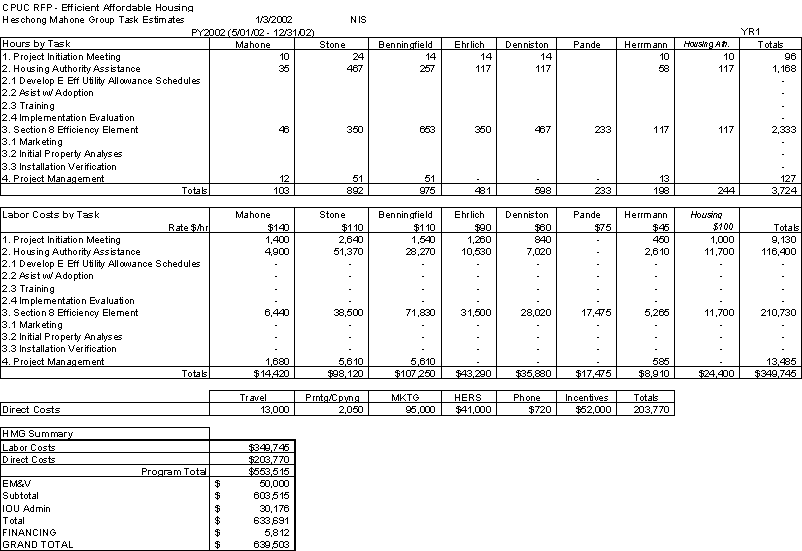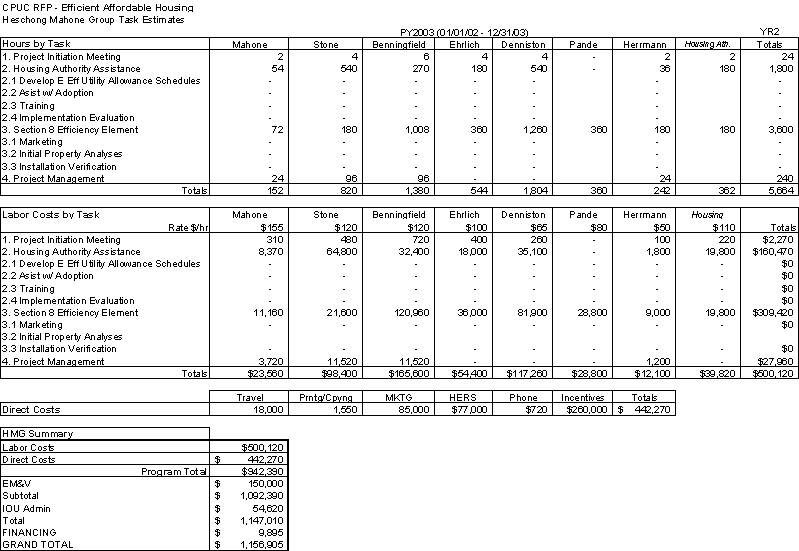Re: Data Request on Proposal p01-21
Dear Mr. Mahone:
Thank you for submitting your proposal (Proposal for an efficient affordable housing program, Number 01-21) to the California Public Utilities Commission. In reviewing your proposal, we have several questions. Please provide the following additional information by noon on Monday, March 18, 2002 to smo@cpuc.ca.gov.
3. Please explain how the financial incentives in the budget will be allocated among participants?
4. What steps will you take to avoid double counting of savings in the event the property owner takes part in other rebate or incentives programs, which will also claim savings, to achieve qualification in your program?
5. Please provide additional detail for the elements contained in the budget items for labor. Also please identify or give examples of activity costs.
6. For areas outside of San Diego, will San Diego Regional Energy Office be a subcontractor? Would your proposal be viable in any other utility territory were the SDG&E portion not selected?
If you wish to mail a hard copy of the requested information, please use the address listed in the above letterhead, Attn: Sheila Otteson If you have questions, you may contact me by e-mail at smo@cpuc.ca.gov or by telephone at 415-703-2010.
Sincerely,
Sheila Otteson
Energy Division
-----Original Message-----
From: Douglas Mahone [mailto:dmahone@h-m-g.com]
Sent: Friday, March 15, 2002 11:40 AM
To: Otteson, Sheila M.
Cc: Nehemiah Stone
Subject: RE: Data Request
Ms. Otteson -
Attached please find our response to your questions. Thanks for your interest. Please let me know if you need further clarification.
The file is a Adobe Acrobat PDF file. Call or e-mail if you have any problems opening it.
Doug.
Douglas Mahone, Partner
Heschong Mahone Group
11626 Fair Oaks Blvd. #302
Fair Oaks, CA 95628
(916) 962-7001
fax (916) 962-0101
web site: www.h-m-g.com
<<Data Request Response.pdf>>
> -----Original Message-----
> From: Otteson, Sheila M. [mailto:smo@cpuc.ca.gov]
> Sent: Thursday, March 14, 2002 8:00 AM
> To: Douglas Mahone
> Subject: Data Request
>
> << File: DR to heschong reference No 255.doc >>
>
Re: Data Request on Proposal p01-21
Dear Mr. Mahone:
Thank you for submitting your proposal (Proposal for an efficient affordable housing program, Number 01-21) to the California Public Utilities Commission. In reviewing your proposal, we have several questions. Please provide the following additional information by noon on Monday, March 18, 2002 to smo@cpuc.ca.gov.
1. Please explain how the financial incentives in the budget will be allocated among participants?
2. What steps will you take to avoid double counting of savings in the event the property owner takes part in other rebate or incentives programs, which will also claim savings, to achieve qualification in your program?
3. Please provide additional detail for the elements contained in the budget items for labor. Also please identify or give examples of activity costs.
4. For areas outside of San Diego, will San Diego Regional Energy Office be a subcontractor? Would your proposal be viable in any other utility territory were the SDG&E portion not selected?
If you wish to mail a hard copy of the requested information, please use the address listed in the above letterhead, Attn: Sheila Otteson If you have questions, you may contact me by e-mail at smo@cpuc.ca.gov <mailto:smo@cpuc.ca.gov> or by telephone at 415-703-2010.
Sincerely,
Sheila Otteson
Energy Division
May 6, 2002
Sheila Otteson
Energy Division
Public Utilities Commission
505 Van Ness Avenue
San Francisco, CA 94102-3298
Dear Ms. Otteson,
We appreciate your effort to better understand our proposal for an innovative Efficient Affordable Housing (EAH) program. Please review our responses below and in the attached documents, and let us know if you need any additional information.
1. The incentives will be paid to property owners for achieving either an improvement of 20% in the energy performance of their rental units or for making the units at least 10% better than current Title 24. Incentives will be paid at the rate of $800 per unit so improved. We estimate that this will cover roughly two thirds of the average cost to make those improvements - a little more than 2/3 for multifamily units and a little less than 2/3 for single family units. Since this program is targeted at properties seeking a Section 8 voucher, most of the units will be multifamily.
We have attached a sheet that shows the derivation of our estimates. On the sheet, the table in the upper right shows how we estimated the cost of a set of improvements needed to achieve the increase in efficiency ($1121). There are other ways that one could get there, but this is a reasonable combination of measures.
The columns in the table in the middle of the page represent the four climate zones on which we intend to concentrate for the first two years (CZs 7, 10, 11 and 12). Directly below the CZ label is the number of properties (one property can have many residential units) we believe we will affect in each of the two years, and the next three rows (yellow) show the estimated (using MICROPAS) energy budgets for one base case residential unit. The next three rows (grey) provide the estimated energy savings by climate zone. These estimates are based on the assumptions listed below the tables. The summary in the bottom left shows the number of participant properties, the number of units, the incentive totals and the average per unit savings.
2. The EAH program will focus on improvements that affect energy use specifically accounted for in Title 24 computer analysis of residential buildings. This includes heating, cooling and water heating energy. The other programs with which we will coordinate could focus on these or appliance efficiency gains. There is no overlap or potential for double counting with programs that help tenants or landlords replace washers, dryers, dishwashers, refrigerators or other home appliances.
We will however, coordinate with other programs that might focus on improvements in the same measures we will target. In those cases, the nature of the coordination itself may obviate the potential for double counting. For example, if there is a program that associates HERS raters with an administrator that offers rebates for making a percentage improvement in existing residences, our part in those projects might only be to assist the housing authority to develop a two tiered utility allowance that fosters investments in efficiency. We would not offer an incentive to anyone to do something for which they are receiving an incentive from some other program. Likewise, if we developed a lead, and had a signed application before the HERS rater becomes involved (to verify the potential, then the actual savings), then we would claim the impacts come from EAH. We will make every effort to achieve the maximum energy efficiency gain with the minimum in total administrative costs for multiple programs.
Our primary effort, and the thing that makes this program unique, will be our efforts to change the housing authorities' approach to setting maximum rents - so that energy efficiency investments are advantaged, not disadvantaged. When we have a chance to effect that change, even if another program gets the credit for the energy savings on the specific project involved, we will do so. Changing the housing authorities' calculations will help to bring about much greater gains in efficiency, for a much broader population of buildings, than the potential savings from any one individual project.
3. For greater detail on the labor budget item, please see the attached budget sheet. As you can see, about one third of the labor budget will be dedicated to assisting the housing authorities in developing, adopting and implementing a utility allowance schedule that fosters energy efficiency investments. About two thirds of our labor will be applied to marketing the program to landlords, assisting them to identify and commit to cost effective efficiency improvements, and verifying installations.
There are two ways that participants can qualify: improve the property to 20% better than it currently is, or improve the property to 10% better than the current Title 24 standards. A portion of our direct labor budget is for verifying the installations (when the path of "10% better than current Title 24 standards" is chosen). before giving them their incentive checks. The line item "Activity Costs" on the Program Cost Proposal (Section 9) is the estimated cost for HERS verification of those installations where "20% better than existing" is the qualification path chosen. This program has the added advantage of fostering the growth of the HERS industry in California.
4. SDREO is only intended to be a subcontractor in the San Diego region. We are proposing this partnership to reduce travel costs and increase the direct presence in the region. We can cost effectively access other area of the state.
You asked whether our proposal would still be "viable in any other service territory were the SDG&E portion not selected." First, the simple answer is yes. However, a more comprehensive answer is in order.
There are two elements to the EAH program: the housing authority element and the property owner element. Although both elements could be pulled from the SDG&E territory, we believe that the San Diego Housing Commission is very close to understanding and adopting a two tiered utility allowance schedule. There would be no effort and no expertise to assist them without EAH. Even if the property owner element of EAH were not offered in San Diego (e.g., because of a duplication with an SDG&E or other third party program), we believe that the housing authority element would be extremely valuable in getting SDHC through the last phase of adopting a new utility allowance schedule. Is it necessary to the success of EAH? No. Is it important to the advancement of energy efficiency in San Diego? Yes!
I hope that this answers all of your questions, but if there is any further clarification that I can help you with, please give me a call.
Sincerely,

Douglas E. Mahone
Partner


STATE OF CALIFORNIA GRAY DAVIS, Governor

PUBLIC UTILITIES COMMISSION
505 VAN NESS AVENUE
SAN FRANCISCO, CA 94102-3298
March 13, 2002



